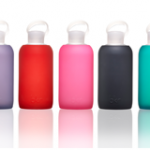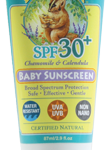Props to the ladies at bkr for creating a glass bottle with functional silicone sleeve that one may use to drink all sorts of beverages from without looking as though embarking on a journey that requires carabiners. The bottles are BPA-free, BPA-replacement free and phthalate-free. $28 is less than a case of Fiji and you can be stylish drinking water from this continent. Best part is the founders are recovering lawyers too. Très chic.
Tag Archives: water
Sunscreen safety
For those of you headed out on vacation, here are some important tips for child sun safety. An infant can burn in less than 10 minutes, even on a cloudy day. Aside from the obvious protection for your child (covering up, long sleeves/pants, hats, etc), be very selective about sunscreen. Here are some quick tips and my number one recommendation for baby sunblock:
1. Look for Zinc Oxide or Titanium Dioxide. These are physical sunscreens, rather than chemical sunscreens. Chemical sunscreens are absorbed into the skin to soak up the wave-lengths of sun so that they don’t penetrate deeper. The longterm effects of ingesting these chemicals is unknown but many chemical sunscreens contain known carcinogens. Another reason to use a physical as opposed to a chemical sunscreen is that babies and toddlers put their hands in their mouths all the time. Zinc oxide and titanium oxide are nontoxic, inert ingredients so they won’t react with any chemicals in the body to cause illness or an allergic reaction. Accordingly, you don’t have to worry about your child ingesting small amounts.
One note, titanium dioxide is somewhat controversial. It is a naturally occuring mineral that is chemically processed. Some studies indicated a slight increase in cancer levels in lab rats with long term exposure but others have concluded that the carcinogenicity of titanium dioxide is so low, it’s not classifiable as a human carcinogen. It is currently listed as non-toxic to humans and has no known adverse effects. This substance should be avoided in nano particle or ultrafine form, however. For more on Titanium Dioxide, read this article.
2. Look for Paraben-Free, PABA-Free, Fragrance Free sunscreen. The reasons should be obvious but in short, this will avoid a host of toxic, carcinogenic chemicals.
3. Get Broad Spectrum. It’s the only way to ensure your child is getting UVA and UVB protection.
4. Avoid Aerosol or Spray Sunscreen, Look for Non-Nano. Sunscreens are dangerous if inhaled or if they get in the eyes. Further, new consumer construct “ultra fine” and “nano” sized particles are absorbed at a more rapid rate by the body and penetrate deeper, thereby increasing the absorption of any toxic chemicals in your sunscreen. If you must use a spray sunblock (some is better than none!), spray it on your hand first, then apply to your baby (or yourself).
5. Check expiration date and monitor consistency and color. Avoid any expired sunscreen and throw out sunscreen that has changed color or consistency. This can affect efficacy and, in the case of chemical sunscreen, increase toxicity.
6. Apply properly and reapply every 2 hours or after swimming. Babycenter has a good video on how to apply sunscreen to your babe here, which should take about 5 minutes if done well. Don’t forget in between fingers and toes, behind ears and the neck and do the face last since it’s the most sensitive area for kids.
7. My sunscreen recommendation is Badger SPF 30+ Baby Sunscreen. It’s broad spectrum, non-nano zinc oxide with mostly certified organic ingredients.


